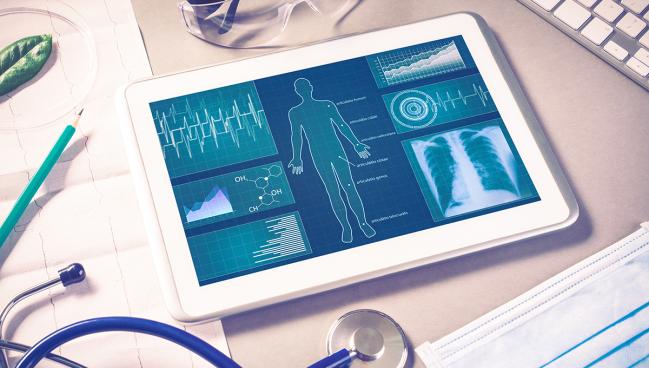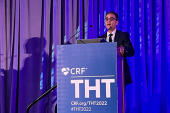HF Devices Have a Role to Play, Even With Today’s GDMT Bonanza
“We should look at drug and device therapies for heart failure as being complementary,” William Abraham says.

BOSTON, MA—Despite the development of multiple classes of safe and effective medications for heart failure over the past few decades, there remains a need for device-based therapies to further improve the lives of patients.
That’s the message that came out of a session on interventional heart failure therapies at the Medtech Innovation Forum that opened the TCT 2022 meeting here.
Even though existing drug and device therapies improve symptoms, clinical outcomes, or both, “heart failure symptom burden remains high and clinical outcomes remain poor,” William Abraham, MD (The Ohio State University Wexner Medical Center, Columbus), said.
“So in this regard, we should look at drug and device therapies for heart failure as being complementary,” he continued. “We need to figure out how to use these together in optimal ways to optimize both patient-centered as well as clinical outcomes.”
Recent years have seen the emergence of several safe and effective guideline-directed medical therapies for heart failure—an angiotensin receptor-neprilysin inhibitor (ARNI), a beta-blocker, a mineralocorticoid receptor antagonist (MRA), and a sodium-glucose cotransporter 2 (SGLT2) inhibitor. Trials have shown reductions in mortality in patients with heart failure with reduced ejection fraction (HFrEF) with all of them, Abraham said, noting that there have been some recent successes with ARNIs and SGLT2 inhibitors in reducing morbidity and mortality in patients with heart failure with preserved ejection fraction (HFpEF) as well.
“But despite these gains, the residual risk that exists in our heart failure patients who are on optimized guideline-directed medical therapy, now four foundational drug therapies, still remains high,” Abraham said.
The residual risk that exists in our heart failure patients who are on optimized guideline-directed medical therapy . . . still remains high. William Abraham
That observation has led to the emergence of device-based heart failure therapies. There are numerous potential targets for interventional heart failure devices, including primary or secondary valve disease, elevated left atrial pressure, LV dilation or pathophysiological remodeling, reduced contractility or cardiac output, autonomic imbalance, LV dissynchrony, and more, Abraham said.
More than 20 years ago, the approval of cardiac resynchronization therapy (CRT) ushered in device-based therapies for heart failure, which have been shown to provide greater relief of symptoms compared with drugs and also improve clinical outcomes. SGLT2 inhibitors have provided an average improvement in Kansas City Cardiomyopathy Questionnaire (KCCQ) score of 1.5 to 2.5 points, which falls shy of the 5-point threshold for a clinically meaningful change, Abraham noted. CRT, on the other hand, has provided an average boost in KCCQ score of 8 to 10 points.
Several other interventional heart failure device therapies have come on the scene since CRT. Between 2014 and 2019, for example, there have been approvals or expanded indications for the CardioMEMS system (Abbott), MitraClip (Abbott), the Optimizer Smart implantable pulse generator (Device Impulse Dynamics), and the Barostim Neo baroreflex activation therapy device (CVRx).
Abraham highlighted use of the MitraClip for functional mitral regurgitation in patients with heart failure as an example of where device-based therapies can make a difference. When the COAPT trial was presented at TCT 2018, there was a standing ovation when the slide showing a substantial reduction in the primary endpoint—heart failure rehospitalizations—was shown, Abraham recalled. And that, he said, “really underscores our response to effective device therapies for the treatment of heart failure.” Of note, the MitraClip-treated patients saw a 12.5-point improvement in KCCQ score after 1 year.
“Device-based therapies play an important role in the management of heart failure patients,” Abraham said. “Some devices, such as CRT and [transcatheter] edge-to-edge mitral repair, prolong survival, reduce the risk of heart failure hospitalization, and improve symptoms and quality of life on top of drug therapies.” And others, like devices for cardiac contractility modulation or baroreflex activation therapy, improve symptoms but haven’t yet been shown provide better clinical outcomes.
“The bottom line here is this has become perhaps the most active and exciting arena within heart failure management—that is, is device-based therapies for the treatment of heart failure,” Abraham said.
This field requires a deeper understanding of physiology in order to determine whether or not a mechanical fix is the right approach and in whom. Navin Kapur
His talk was followed up by another by Navin Kapur, MD (Tufts Medical Center, Boston), who provided an overview of the interventional heart failure landscape. To bring home the importance of having this discussion at TCT, he pointed out that heart failure affects many of the patients treated by interventional cardiologists.
Device-based heart failure therapies that have been proven successful include TAVI, transcatheter edge-to-edge repair, transcatheter alcohol septal ablation, and endovascular mechanical circulatory support, Kapur said.
But the problems affecting patients with heart failure are not always amenable to a mechanical fix, as there may be underlying physiological issues at play, and that presents a challenge when developing new device-based treatments. “I think this field requires a deeper understanding of physiology in order to determine whether or not a mechanical fix is the right approach and in whom,” Kapur said.
He provided some examples of device therapies that have not yet been proven to work, and he stressed the word “yet.” In that category, he placed interatrial shunts, splanchnic denervation, aortic impellers, and the preCARDIA system.
During a panel discussion, Mariell Jessup, MD, chief science and medical officer of the American Heart Association, raised a question about whether the type of patient with congestive heart failure that existed decades ago before the advent of the foundational drug therapies—for whom device-based therapies were developed—still exists today.
Kapur responded by noting that patients hospitalized with heart failure now can stay in the hospital for a long time. “They’re definitely not crashing and burning, but they’re also not decongesting,” he said, underscoring that there is a subset of patients who don’t respond to maximal diuretic escalation.
“This is where the question comes into play: can we do this better? And it has to be a combination of drug and device therapies,” Kapur said.
Todd Neale is the Associate News Editor for TCTMD and a Senior Medical Journalist. He got his start in journalism at …
Read Full BioSources
Multiple presentations. Interventional heart failure: shunts, pumps, and beyond. Presented at: TCT 2022. September 16, 2022. Boston, MA.
Disclosures
- Abraham reports fees related to consulting or speaking from AquaPass, Cordio, Edwards Lifesciences, Respicardia, Vectorious Medical, and White Swell; salary support from V-Wave Medical; and equity, stocks, or options from Cardionomic.
- Kapur reports grant support/research contracts from Abiomed and Boston Scientific, as well as fees related to consulting or speaking from Abbott Vascular, Abiomed, Boston Scientific, LivaNova, Precardia, and Zoll.





Comments